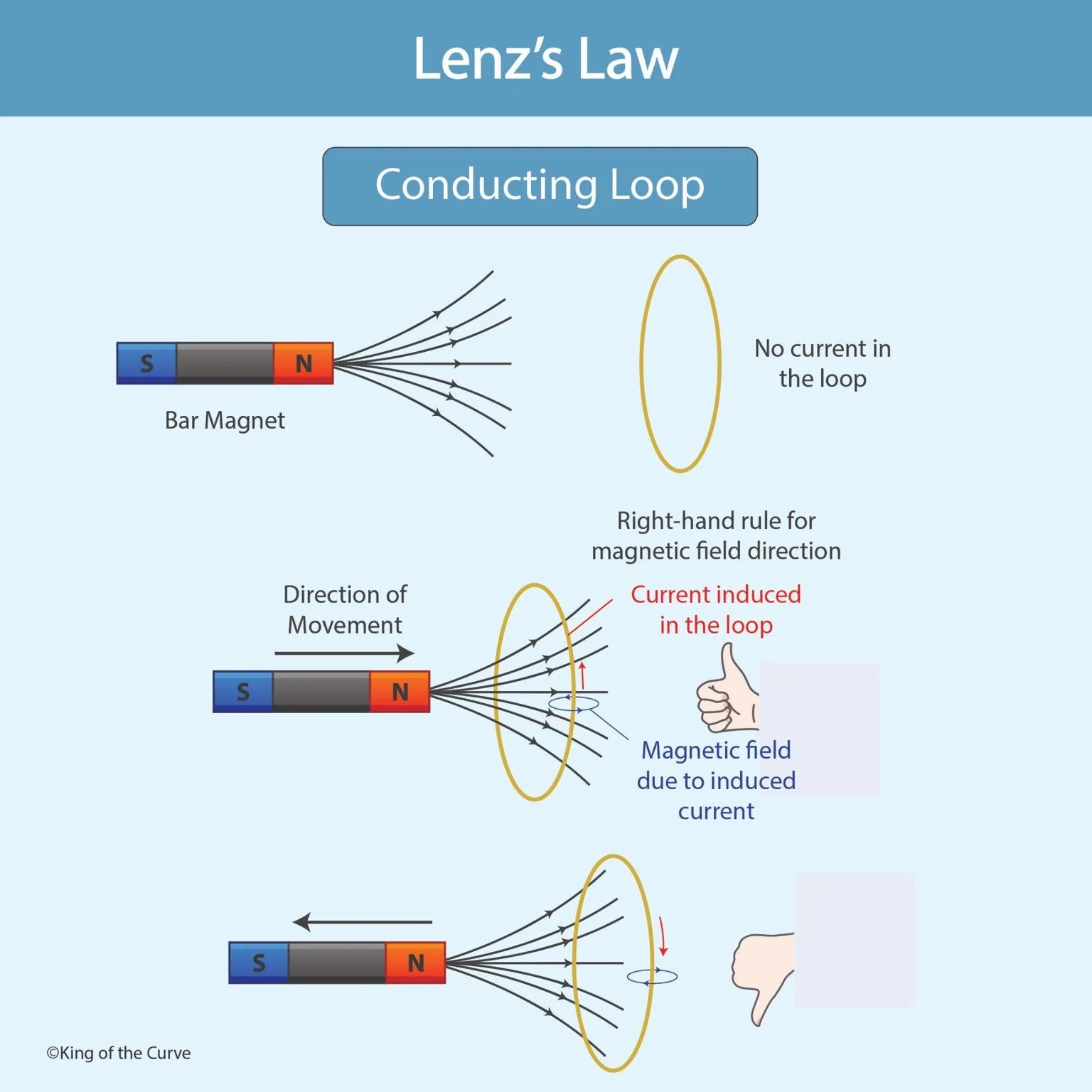⚡ Lenz’s Law: Understanding Magnetic Induction Through Motion
Have you ever wondered how moving a magnet near a wire loop can create electricity?
That’s the magic of Lenz’s Law, a key principle of electromagnetic induction.
For students preparing for the MCAT, USMLE Step 1, or engineering exams, Lenz’s Law explains how changing magnetic fields produce induced currents — the foundation for electric generators, MRI machines, and cardiac pacemakers.
🧲 The Principle Behind Lenz’s Law
Lenz’s Law states:
“The direction of the induced current in a conductor is such that it opposes the change in magnetic flux that produced it.”
This law stems directly from Faraday’s Law of Induction, which quantifies the induced electromotive force (EMF):
| Symbol | Meaning | Explanation |
|---|---|---|
| EMF | Electromotive Force | The voltage induced in a circuit by a changing magnetic field. |
| − | Negative Sign | Represents Lenz’s Law: the induced current opposes the change in magnetic flux. |
| \(\dfrac{d\Phi_B}{dt}\) | Rate of Change of Magnetic Flux | Measures how fast the magnetic field through an area is changing over time. |
| \(\Phi_B = B \times A \times \cos\theta\) | Magnetic Flux | Depends on magnetic field strength (B), area of the loop (A), and the angle (θ) between them. |
Where:
ΦB\Phi_BΦB = Magnetic flux (B × A × cosθ)
The negative sign represents Lenz’s opposition to flux change.
💡 Remember:
That minus sign isn’t just math — it represents nature’s resistance to change, conserving energy in the process.
🔄 How It Works (Step-by-Step)
1️⃣ Magnet Approaches the Loop:
Magnetic field through the loop increases.
The loop generates a current whose field opposes the incoming magnet’s field (repulsion).
2️⃣ Magnet Moves Away:
Magnetic flux decreases.
The induced current reverses direction, attracting the retreating magnet to resist the change.
3️⃣ Energy Connection:
Work done to move the magnet → converted into electrical energy in the loop.
📊 Quick Summary Table
| Scenario | Magnet’s Motion | Flux Change | Induced Current Direction | Loop’s Magnetic Response |
|---|---|---|---|---|
| Toward Loop | Increases | Magnetic flux increases | Counterclockwise (creates opposing N pole) | Repels magnet |
| Away from Loop | Decreases | Magnetic flux decreases | Clockwise (creates attracting S pole) | Attracts magnet |
| Stationary Magnet | None | Constant | No current induced | No response |
💡 Exam Tip:
Use the Right-Hand Rule — thumb points in magnetic field direction, curled fingers show induced current.
⚕️ Clinical & Real-World Applications
Lenz’s Law isn’t just theory — it powers modern medicine and technology:
MRI Machines: Changing magnetic fields induce current in tissue (why MRI techs warn about metal!).
Pacemaker Interference: External magnets can alter device currents through induction.
Electric Braking Systems: Induced currents in metals oppose motion for smooth stops.
Generators & Transformers: Entire power grids run on this principle.
🧩 MCAT & USMLE Connection
You’ll see this concept tested in:
MCAT Physics: Induced currents, energy conservation, and right-hand rule applications.
USMLE Physiology: Biomedical device safety, MRI physics, and electromagnetic effects on tissues.
Engineering Exams: Induction motors, flux changes, and circuit design.
🌍 Beyond the Exam: Why It Matters
Lenz’s Law teaches us that nature resists sudden change, a principle extending beyond physics. From cardiac defibrillation currents to regenerative braking, it’s a perfect example of how science balances energy and motion.
🔑 Call to Action
Visual learning transforms tough physics into clear understanding.
Join King of the Curve for interactive MCAT visuals, adaptive practice, and curve coins gamification to make learning effortless.
Frequently Asked Questions (FAQs)
-
Aim for 4-6 focused hours, ensuring you incorporate breaks to avoid burnout.
-
Practice mindfulness techniques, take practice exams under realistic conditions, and maintain a balanced lifestyle.
-
Set short-term goals, seek support from mentors, and reward yourself for small achievements.
-
Regular exercise improves focus, reduces stress, and enhances overall mental clarity.
-
KOTC offers personalized learning tools, gamification features, and adaptive question banks to help students stay on track without burnout.


